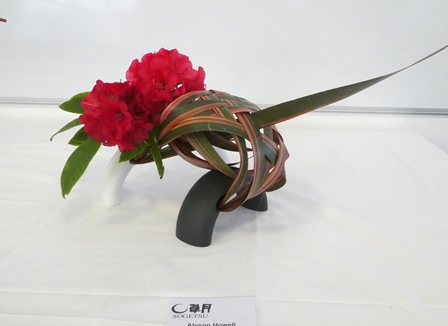Tulip Sunday is the main focus of this event, but it also includes guided walks, music events and for the 3rd time, our Ikebana Exhibition. The Exhibition ran from Friday to Sunday and the venue was the conference room at the Treehouse Visitors Centre. The Festival events are all detailed in the Wellington City Council’s quarterly “Our Wellington” booklet, which is distributed to every Wellington household, so we do not need to do much publicity ourselves.
Ikebana International had been involved with this Festival for many years, giving lessons to the public. Then three years, ago we were invited to exhibit Ikebana. The first year we exhibited, we created spring themed exhibition arrangements and again gave lessons for the public.
The second year, we had a visiting tutor giving three workshops before the exhibition, and the resulting arrangements became the basis of the exhibition. The workshop themes were… Book 5 Lesson 13 “an arrangement in a see-through container”, and Book 5 Lesson 18 “a composition expressing a movement” in a nageire or moribana or a morimono floating version, ( Book 2 Lesson 16) all with spring flowers and native New Zealand foliage. Instead of lessons for the public, the teachers gave short demonstrations in one corner of the exhibition space. These were well attended and very successful.
This year we had used our usual Sogetsu group monthly Sunday workshop in September, to practice the arrangements for the exhibition. The chosen brief was to use spring material with light coloured containers suitable for white tablecloths. Our exhibition coordinator Elizabeth, conducted the workshop focussing on exhibiting in general, referencing Book 5, Lesson 25. She discussed differing wall backgrounds, table cloth and vase colours and how they affected the arrangements and overall exhibition look. Because we had used the Treehouse venue before, we were well versed on the various issues for this venue but you can take nothing for granted. This year we found the thick blackout window curtains had been replaced by white sun filter roller blinds, which created a different background for one wall and did not block out the bright afternoon sun from this south facing room at all.
Elizabeth also discussed what flowers would last for the three day exhibition, and we chipped in with our own personal successes and failures with various materials. She also asked us all to do a sketch of our intended arrangement, as the Sogetsu textbook requires. This not only helped us to focus our thoughts, but helped Elizabeth to begin to make a mock-up of the actual exhibition table order. Photos taken at the end of the workshop also helped with this. The idea of a practice beforehand was a good one, but we had to be prepared for the eventuality that we may not be able to obtain the same flower/plant material as there was a three week gap between the practice and the exhibition.
Also this year, we were able to use the main reception room, as well as the conference room. Three teachers did “teaser” arrangements on the Monday before the exhibition, to entice people back for the weekend exhibition. We put up our Wellington Ikebana banners, and the Gardens had created a poster advertising the exhibition. The downside of using the reception room was it was north facing, very sunny and hot, and it had an east facing automatic main door letting in gusts of wind. Once the arrangements were up on the Monday morning, a teacher had to visit daily to top up the water and replace wilting delicate spring flowers.
The Ikebana students came on the Friday morning and put up their arrangements quickly, so we were able to welcome people in before the opening time of noon. Some arrangements were faithfully recreated as planned, but others changed colour as in one case yellow freesias were unobtainable and the arrangement had to feature pink ones instead. Extra signage was put up with arrows directing visitors from the reception to the adjoining conference room, and we had the latest Sogetsu brochures to give away and another one listing teachers and lesson times in various locations in Wellington. For various reasons we were a smaller group this year, so we were somewhat stretched to supply hosts and demonstration assistants for the two and a half days, but it all worked out well in the end.
One of the students turned up with some unusual beautiful purple flowering branches, which no one had seen before. It turned out to be Paulownia, bought from a florist. It is always great to see new plant material used in arrangements. The Paulownia tree is considered by the Japanese to be auspicious and is often seen in patterns with bamboo, chrysanthemums and cranes. The upright flowers are also often seen in family crests. The tree wood is very light and used for making storage chests.
Many of the exhibition visitors were tourists and were interested in the plant materials we had used, especially the stunning proteas. An Auckland resident South African couple and a group of three Japanese tourists, were astounded to see the unusual proteas and surprised to hear they could grow in New Zealand. Many visitors assumed the exhibition flowers had come from the Botanic Gardens outside and were surprised to learn at lot of material had come from our own individual gardens.
Overall it was another successful exhibition. While most of the students had exhibited before, there is always something new to learn from such an experience and this helps us to become better practitioners of Ikebana. Whilst we did not keep a daily count of visitors, demonstrations audiences ranged from 9 to 17 people. The public were very admiring and appreciative of our work and we are always hopeful one or two may come to lessons.
Gallery of work by our Sogetsu Teachers and the surrounding gardens































